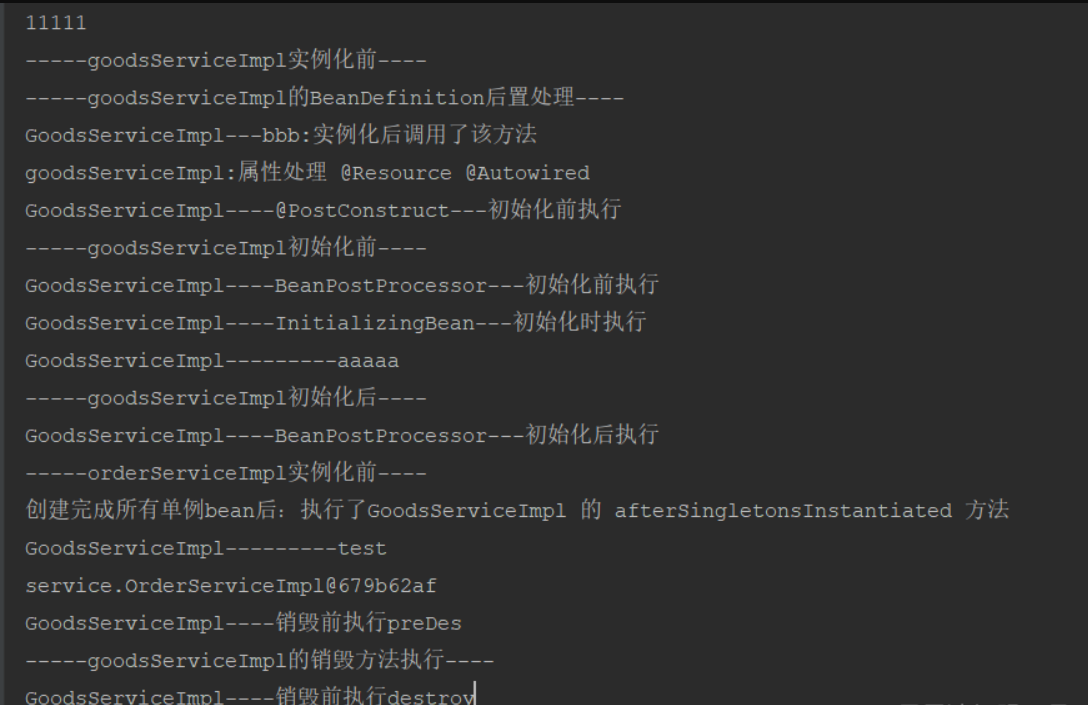Bean的销毁过程
在Bean创建过程中,在最后(初始化之后),有一个步骤会去判断当前创建的Bean是不是。就是在doCreateBean方法中的registerDisposableBeanIfNecessary(beanName, bean, mbd);下面来看下这个方法
protected void registerDisposableBeanIfNecessary(String beanName, Object bean, RootBeanDefinition mbd) {
AccessControlContext acc = (System.getSecurityManager() != null ? getAccessControlContext() : null);
//requiresDestruction(bean, mbd)判断这个bean有没有需要执行销毁的方法
if (!mbd.isPrototype() && requiresDestruction(bean, mbd)) {
//判断是否是单例
if (mbd.isSingleton()) {
//如果单例的bean有销毁的方法 registerDisposableBean这个方法表示 把销毁的方法相关内容和beanName存放到一个map中
//new DisposableBeanAdapter()一个适配器 适配器模式 创建销毁方法的方式很多 需要进行适配
registerDisposableBean(beanName, new DisposableBeanAdapter(
bean, beanName, mbd, getBeanPostProcessorCache().destructionAware, acc));
}
else {
// A bean with a custom scope...
Scope scope = this.scopes.get(mbd.getScope());
if (scope == null) {
throw new IllegalStateException("No Scope registered for scope name '" + mbd.getScope() + "'");
}
scope.registerDestructionCallback(beanName, new DisposableBeanAdapter(
bean, beanName, mbd, getBeanPostProcessorCache().destructionAware, acc));
}
}
}
首先判断这个bean如果是非原型的,接着判断requiresDestruction(bean, mbd)有没有定义销毁的逻辑。
protected boolean requiresDestruction(Object bean, RootBeanDefinition mbd) {
//DisposableBeanAdapter.hasDestroyMethod(bean, mbd) 判断这个bean有没有定义销毁方法
//hasDestructionAwareBeanPostProcessors() 判断有没有实现 DestructionAwareBeanPostProcessor这个接口的bean
//DisposableBeanAdapter.hasApplicableProcessors 判断有没有销毁的方法
return (bean.getClass() != NullBean.class && (DisposableBeanAdapter.hasDestroyMethod(bean, mbd) ||
(hasDestructionAwareBeanPostProcessors() && DisposableBeanAdapter.hasApplicableProcessors(
bean, getBeanPostProcessorCache().destructionAware))));
}
下面分别看下DisposableBeanAdapter.hasDestroyMethod,hasDestructionAwareBeanPostProcessors(),DisposableBeanAdapter.hasApplicableProcessors这个三个方法是如何判断bean有没有定义销毁逻辑的
DisposableBeanAdapter.hasDestroyMethod
public static boolean hasDestroyMethod(Object bean, RootBeanDefinition beanDefinition) {
//大致过程就是 判断这个bean有没有实现DisposableBean 或者 AutoCloseable接口 有的话说明定义了销毁方法
if (bean instanceof DisposableBean || bean instanceof AutoCloseable) {
return true;
}
//如果没有进入到这个方法进一步判断
return inferDestroyMethodIfNecessary(bean, beanDefinition) != null;
}
private static String inferDestroyMethodIfNecessary(Object bean, RootBeanDefinition beanDefinition) {
//从beanDefinition获取一个销毁的属性值
String destroyMethodName = beanDefinition.resolvedDestroyMethodName;
if (destroyMethodName == null) {
//获取销毁的方法名
destroyMethodName = beanDefinition.getDestroyMethodName();
//这个if表示 如果获取这个销毁的方法名 是 (inferred) 这个字符串的话 就会进一步判断 最后返回销毁的方法名 没有返回""
if (AbstractBeanDefinition.INFER_METHOD.equals(destroyMethodName) ||
(destroyMethodName == null && bean instanceof AutoCloseable)) {
// Only perform destroy method inference or Closeable detection
// in case of the bean not explicitly implementing DisposableBean
destroyMethodName = null;
//如果这个bean没有实现DisposableBean的话执行下面逻辑
if (!(bean instanceof DisposableBean)) {
try {
//判断这个bean有没有定义 一个叫close的方法
destroyMethodName = bean.getClass().getMethod(CLOSE_METHOD_NAME).getName();
}
catch (NoSuchMethodException ex) {
try {
//判断这个bean有没有定义 一个叫shutdown的方法
destroyMethodName = bean.getClass().getMethod(SHUTDOWN_METHOD_NAME).getName();
}
catch (NoSuchMethodException ex2) {
// no candidate destroy method found
}
}
}
}
//把销毁的方法名放入到resolvedDestroyMethodName这个属性中 说明已经经过判断
beanDefinition.resolvedDestroyMethodName = (destroyMethodName != null ? destroyMethodName : "");
}
//返回方法名
return (StringUtils.hasLength(destroyMethodName) ? destroyMethodName : null);
}
DisposableBeanAdapter.hasDestroyMethod大致过程就是判断bean是不是实现了DisposableBean 或者AutoCloseable接口,如果没有判断beanDefinition有没有配置对应的销毁方法。
hasDestructionAwareBeanPostProcessors()和DisposableBeanAdapter.hasApplicableProcessors
protected boolean hasDestructionAwareBeanPostProcessors() {
return !getBeanPostProcessorCache().destructionAware.isEmpty();
}
public static boolean hasApplicableProcessors(Object bean, List<DestructionAwareBeanPostProcessor> postProcessors) {
if (!CollectionUtils.isEmpty(postProcessors)) {
for (DestructionAwareBeanPostProcessor processor : postProcessors) {
if (processor.requiresDestruction(bean)) {
return true;
}
}
}
return false;
}
判断bean有没有实现DestructionAwareBeanPostProcessor接口,如果有的话接着执行DisposableBeanAdapter.hasApplicableProcessors因为这是与的关系,DisposableBeanAdapter.hasApplicableProcessors这个方法中会执行DestructionAwareBeanPostProcessor接口中的requiresDestruction方法,如果返回true表示该bean有对应的销毁逻辑,返回false表示没有。
经历了上述步骤后,所有定义了销毁逻辑的bean,都记录在一个map当中。那么什么时候调用这些销毁的逻辑呢?那么就会有人说bean销毁的时候,那么bean什么时候销毁的呢?有人说垃圾回收的时候,但是垃圾回收并不会触发销毁逻辑,GC是jvm层面的不会触发spring定义的销毁逻辑。
Bean销毁是发生在Spring容器关闭过程中的。比如
AnnotationConfigApplicationContext context = new AnnotationConfigApplicationContext(AppConfig.class);
Object obj = context.getBean("goodsServiceImpl");
GoodsServiceImpl goodsService = (GoodsServiceImpl)obj;
goodsService.test();
context.close();
后续调用销毁逻辑都在close方法里面。
在Spring容器关闭过程时:
- 首先发布ContextClosedEvent事件
- 调用lifecycleProcessor的onCloese()方法
- 销毁单例Bean
i. 遍历disposableBeans
a. 把每个disposableBean从单例池中移除
b. 调用disposableBean的destroy()
c. 如果这个disposableBean还被其他Bean依赖了,那么也得销毁其他Bean
d. 如果这个disposableBean还包含了inner beans,将这些Bean从单例池中移除掉 (inner bean参考https://docs.spring.io/spring-framework/docs/current/spring- framework-reference/core.html#beans-inner-beans)
ii. 清空manualSingletonNames,是一个Set,存的是用户手动注册的单例Bean的 beanName
iii. 清空allBeanNamesByType,是一个Map,key是bean类型,value是该类型所有的 beanName数组 iv. 清空singletonBeanNamesByType,和allBeanNamesByType类似,只不过只存了单例 Bean
到此整个bean的生命周期就结束了。
bean生命周期总结
bean在创建过程中经历以下步骤
- 生成BeanDefinition
- 合并BeanDefinition
- 加载类
- 实例化前
- 实例化
- BeanDefinition的后置处理
- 实例化后
- 自动注入和处理属性
- 执行Aware回调
- 初始化前
- 初始化
- 初始化后
- 记录所有定义了销毁逻辑的bean
bean销毁的步骤
- 首先发布ContextClosedEvent事件
- 调用lifecycleProcessor的onCloese()方法
- 销毁单例Bean
spring生命周期的扩展点
在bean的生命周期中,spring提供了一些扩展点,可以干预到bean的创建和销毁,注解类型例如
@PostConstruct 标注该注解的方法会在 初始化前执行
@PreDestroy 标注该注解的方法会在bean销毁的时候执行
接口类型的例如BeanPostProcessor及其子类接口,InitializingBean这只用xxxbean接口。
扩展点有很多,下面通过代码来展示一些扩展点
//扫描路劲,换成自己项目的包路径
@ComponentScan(basePackages = {"service","config"})
public class AppConfig {}
@Component
public class MyBeanPostProcessor implements InstantiationAwareBeanPostProcessor, MergedBeanDefinitionPostProcessor, DestructionAwareBeanPostProcessor {
/**
* 实例化前
* @param beanClass
* @param beanName
* @return
* @throws BeansException
*/
@Override
public Object postProcessBeforeInstantiation(Class<?> beanClass, String beanName) throws BeansException {
if ("goodsServiceImpl".equals(beanName)){
System.out.println("-----goodsServiceImpl实例化前----" );
}
if ("orderServiceImpl".equals(beanName)){
System.out.println("-----orderServiceImpl实例化前----" );
}
return null;
}
/**
* 实例化后
* @param bean
* @param beanName
* @return
* @throws BeansException
*/
@Override
public boolean postProcessAfterInstantiation(Object bean, String beanName) throws BeansException {
if ("goodsServiceImpl".equals(beanName)){
GoodsServiceImpl goodsService = (GoodsServiceImpl)bean;
goodsService.bbb();
}
return true;
}
/**
* 依赖注入和属性处理
* @param pvs
* @param bean
* @param beanName
* @return
* @throws BeansException
*/
@Override
public PropertyValues postProcessProperties(PropertyValues pvs, Object bean, String beanName) throws BeansException {
if ("goodsServiceImpl".equals(beanName)){
System.out.println("goodsServiceImpl:属性处理 @Resource @Autowired");
}
return pvs;
}
/**
* 初始化前
* @param bean
* @param beanName
* @return
* @throws BeansException
*/
@Override
public Object postProcessBeforeInitialization(Object bean, String beanName) throws BeansException {
if ("goodsServiceImpl".equals(beanName)){
System.out.println("-----goodsServiceImpl初始化前----" );
GoodsServiceImpl goodsService = (GoodsServiceImpl)bean;
goodsService.goodsTest1();
}
return bean;
}
/**
* 初始化后
* @param bean
* @param beanName
* @return
* @throws BeansException
*/
@Override
public Object postProcessAfterInitialization(Object bean, String beanName) throws BeansException {
if ("goodsServiceImpl".equals(beanName)){
System.out.println("-----goodsServiceImpl初始化后----" );
GoodsServiceImpl goodsService = (GoodsServiceImpl)bean;
goodsService.goodsTest2();
}
return bean; }
/**
* BeanDefinition的后置处理
* @param rootBeanDefinition
* @param aClass
* @param beanName
*/
@Override
public void postProcessMergedBeanDefinition(RootBeanDefinition rootBeanDefinition, Class<?> aClass, String beanName) {
if ("goodsServiceImpl".equals(beanName)){
System.out.println("-----goodsServiceImpl的BeanDefinition后置处理----" );
rootBeanDefinition.setInitMethodName("aaa");
rootBeanDefinition.getPropertyValues().add("orderService",new OrderServiceImpl());
}
}
/**
* 具体的销毁逻辑 bean 销毁时执行
* @param bean
* @param beanName
* @throws BeansException
*/
@Override
public void postProcessBeforeDestruction(Object bean, String beanName) throws BeansException {
if ("goodsServiceImpl".equals(beanName)){
System.out.println("-----goodsServiceImpl的销毁方法执行----" );
}
}
/**
* 初始化完成后 通过返回值判断有没有自定义的销毁逻辑
* @param bean
* @return
*/
@Override
public boolean requiresDestruction(Object bean) {
return true;
}
}
service类
@Service
public class OrderServiceImpl {
public void test(){
System.out.println("OrderServiceImpl---test");
}
}
@Service
@Conditional(GoodsConditional.class)
public class GoodsServiceImpl implements SmartInitializingSingleton, InitializingBean, DisposableBean {
private OrderServiceImpl orderService;
public void setOrderService(OrderServiceImpl orderService) {
this.orderService = orderService;
}
public void test(){
System.out.println("GoodsServiceImpl---------test");
System.out.println(orderService);
}
@Override
public void afterSingletonsInstantiated() {
System.out.println("创建完成所有单例bean后:执行了GoodsServiceImpl 的 afterSingletonsInstantiated 方法");
}
public void aaa(){
System.out.println("GoodsServiceImpl---------aaaaa");
}
public void bbb(){
System.out.println("GoodsServiceImpl---bbb:实例化后调用了该方法");
}
@PostConstruct
public void goodsTest(){
System.out.println("GoodsServiceImpl----@PostConstruct---初始化前执行");
}
public void goodsTest1(){
System.out.println("GoodsServiceImpl----BeanPostProcessor---初始化前执行");
}
public void goodsTest2(){
System.out.println("GoodsServiceImpl----BeanPostProcessor---初始化后执行");
}
@Override
public void afterPropertiesSet() throws Exception {
System.out.println("GoodsServiceImpl----InitializingBean---初始化时执行");
}
@PreDestroy
public void preDes(){
System.out.println("GoodsServiceImpl----销毁执行preDes");
}
@Override
public void destroy() throws Exception {
System.out.println("GoodsServiceImpl----销毁执行destroy");
}
}
条件判断类
public class GoodsConditional implements Condition {
@Override
public boolean matches(ConditionContext conditionContext, AnnotatedTypeMetadata annotatedTypeMetadata) {
//业务判断
System.out.println("11111");
return true;
}
}
测试类
public class Test {
public static void main(String[] args) {
AnnotationConfigApplicationContext context = new AnnotationConfigApplicationContext(AppConfig.class);
Object obj = context.getBean("goodsServiceImpl");
GoodsServiceImpl goodsService = (GoodsServiceImpl)obj;
goodsService.test();
context.close();
}
}
运行结果





















 266
266











 被折叠的 条评论
为什么被折叠?
被折叠的 条评论
为什么被折叠?








